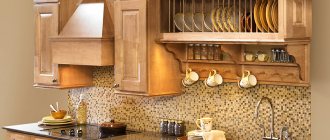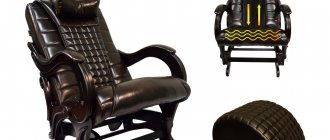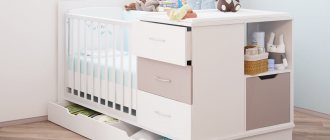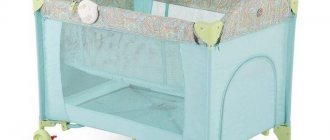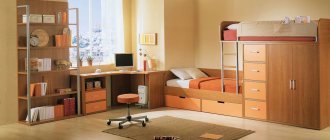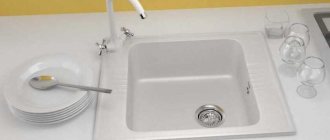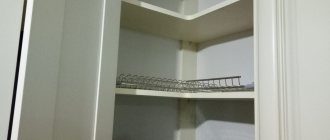SHARE ON SOCIAL NETWORKS
FacebookTwitterOkGoogle+PinterestVk
A necessary attribute of every kitchen is a dish drainer. When choosing such a device, various questions may arise. Dish drainers are made from different materials. They are classified by shape, fastening, and number of levels. The optimal solution for the kitchen space is integrated models of dryers. However, before making a choice, you need to pay attention to other types of structures.
Manufacturers offer a huge selection of dish dryers
The main types of kitchen dryers and their characteristics
Dryers installed in the kitchen can have different designs. They are also classified according to other criteria. All devices that are used for drying dishes are differentiated into varieties depending on the installation method. In accordance with this feature, dryers are distinguished:
Dish dryers may vary in design and material
- mounted on the sink;
- built-in;
- desktop;
- mounted
Constructions belonging to the first group are quite common. Dish dryers of this type are most often made of stainless steel. They are fixed to the sink and are easy to use. Such designs are not very spacious. Dryers that are installed on the sink are also called troflexes. The modern market offers the buyer several varieties of such structures, namely: meshes, gratings, and boards with perforations.
Built-in dryer models are the most common, as they are the optimal solution for a modern kitchen. It is customary to install such products in a kitchen set, which allows you to hide the dishes from prying eyes. Drying racks for dishes in a cabinet, cabinet or drawer can be made of metal, plastic, and wood.
The design of integrated dryers can be simple or complex. In the first case, the product includes two tiers. The lower one is used for mugs, and the upper one is usually reserved for plates. Dryers that are more complex from a design point of view may have additional compartments that are intended for glasses and other kitchen utensils.
Dryers built into the kitchen cabinet are the optimal solution for the kitchen
All integrated structures are necessarily equipped with special pallets. For drying dishes, this solution is very convenient, as it allows you to put plates and mugs in this device immediately after washing them. The downside of such models is that the moisture that concentrates in the tray has an adverse effect on the furniture.
Helpful information! Most dryers integrated into cabinets are equipped with only one tray (for the lower tier). Experts advise choosing models in which each level has its own tray.
Tabletop dryers are installed on a flat surface located in close proximity to the sink. Most often they are placed on the countertop. Such structures are divided into two types: folding and stationary. In addition, tabletop models are classified by the number of tiers. When choosing a tabletop device, it is worth considering that it should fit into the interior of the kitchen space, as it is always in sight.
Wall-mounted dryers are fixed directly to the wall (not far from the sink) or installed in cabinets. When choosing a wall-mounted dish dryer, you need to pay attention to its dimensions. The dimensions of the product must correspond to the available free space.
The tabletop dish dryer can be placed in any convenient place near the sink
Dryer selection criteria
There are several items you should pay attention to when buying a kitchen dryer.
Materials
There is little variety here, because the main requirement for the materials from which dish dryers are made is strength and moisture resistance. Therefore, manufacturers offer devices made from the following materials.
- Steel products coated with chrome or enamel. The first option is better because chrome plating is a layer with long-term use. In this regard, enameled structures lose. Unfortunately, the enamel does not withstand frequent shock loads, which is common for a dryer.
- Made from stainless steel. Expensive model, but with a long service life. In addition, such a dryer will require special maintenance.
- Plastic ones are the cheapest, but light and bright products. Unfortunately, they do not have a long service life. The products are made of durable plastic, but there are also very cheap devices on the market that will not last even a year.
- Wooden. Wood is often used as a material for making dryers. It is coated with special water-repellent compounds, so it copes well with water and moisture. True, manufacturers recommend periodically coating wooden devices with protective mixtures to extend their service life. In addition, wood fits perfectly into any kitchen interior design.
Read also: Which frying pan is suitable for a glass-ceramic stove
Pallets are made of stainless steel or plastic. Both materials have virtually no wear life. In addition, they are hygienic and easy to clean.
Size range
The dryer option in terms of size is a small model range, which is determined by the range of 40-80 centimeters with a gradation of 10 centimeters. And the larger the size, the more dishes will fit on the dryer. For example, only 12 plates fit on a drying rack 40 centimeters long. And for a device 60 centimeters long – already 18.
However, some models have standard sizes. For example, the dimensions of built-in structures, or, more precisely, their width, are determined by the width of the wall cabinet. It has a standard size of 60 centimeters. Although designers claim that 60 centimeters is the optimal size for desktop structures.
When choosing a multi-tiered model, you need to pay attention to the distance between the levels. It should not be less than 30 centimeters; this will allow you to install plates with a larger diameter on the lower tier. Devices longer than 60 centimeters are made with two pallets. The latter must be removable or retractable.
Alternative option
The dish drainer does not necessarily have a wire rack or mesh. Today, rugs with dimensions of 30x40 or 50x60 centimeters have appeared on the market. They are spread out near the sink and wet dishes are placed on them. As soon as the water has drained, the dishes are put on the shelves, and the rug is rolled up and put in a drawer.
Today, manufacturers offer rugs made from different materials:
- Rubber, silicone, plastic with a ribbed or corrugated surface. Water collects between the ribs, which can be easily drained and the mat dried or wiped dry.
- Fabric, which includes fiber made from synthetic fibers. Such rugs absorb moisture, after which they have to be dried. But in terms of workmanship and service life, they are not inferior to models from the first category.
Dish dryer in a cupboard: types and design features
Models that are located inside the kitchen unit are the most acceptable. They are recommended by most experts, as they are convenient and invisible to prying eyes. It is very important that such designs do not require careful selection. The main factors by which these dryer models differ:
- form;
- dimensions;
- material of manufacture;
- installation location.
Taking into account the above-described nuances, the choice of the required design is greatly simplified. All products that are integrated into the kitchen set are divided into two types: stationary and retractable. Models of the first type are mounted inside the upper cabinets. Structures belonging to the second group are installed in the lower cabinet.
The retractable model is a box divided into several compartments. As a rule, such a product does not have sides. This type of structure is made entirely of metal and has a furniture façade. The main advantage of such dryer models is that they are very easy to use.
Most often, dryers built into a cabinet are placed directly above the sink.
The shape and configuration of retractable kitchen drainers may vary. Among other things, some models have a greater functional load. This parameter should also be taken into account when choosing such a design. Multifunctional drying racks are designed to accommodate not only plates and spoons, but also other kitchen utensils (glasses, cups, etc.).
Dish drying racks in the lower cabinet rarely have two or more tiers. Most often this is a single-level design. In turn, dryers, which are integrated into the upper floor of the kitchen unit, are distinguished by a wide variety of models. It is not at all necessary to buy a special device for this purpose.
Note! You can also install a regular desktop model in the cabinet. The only thing worth considering is that it must have a pallet.
Today, IKEA offers a large range of integrated models. Dish dryers mounted in upper cabinets are classified according to the number of tiers into single-level and two-level. A universal solution is a two-tier design, as it allows you to dry all the necessary dishes. Of course, such dryers are not intended for pots and pans.
Some kitchen units are equipped with a cabinet for drying dishes
Single-level models, due to their design, may have different functionalities. For example, there are devices that are used only for plates. Experts recommend paying attention to combined models of single-level dish dryers. A cabinet for installing such a design must have suitable dimensions and be located near the sink.
According to their shape, all products of this type are divided into straight and angular. The material for the manufacture of integrated dryers can be metal or plastic, less often wood. Plastic models are cheaper, which is a definite advantage.
Material for production
Dryers for kitchen utensils are divided into the following categories depending on the material from which they are made:
Most products use steel, which is pre-coated with a special coating that prevents corrosion processes. This method of protection can significantly extend the life of an object. Many buyers like this particular type of material because of its pleasant metallic color and glossy shine.
This standard option has an adequate price-quality ratio. The durable material has wear-resistant properties, so it can serve for a long time and properly.
These models are popular among buyers on the domestic market because buying a plastic structure is inexpensive. The main disadvantage of this material is its short service life and rapid loss of presentation. Under the influence of water, heat, direct sunlight, the surface loses its original color and brightness. Another disadvantage is the fragility of the material. Do not overload the dryer by placing too many dishes on it. Otherwise, it may bend or even break under heavy weight.
A wooden dish drainer is the choice of true aesthetes and connoisseurs of classic style in the interior. You can dry dishes on it only if the wood is coated with a special protective compound that prevents the processes of rotting and destruction. It is not suitable for every owner, as it is used more as a design highlight.
Straight and corner dish drainers built into cabinets
When choosing an integrated dryer model, you need to pay attention to its shape. Today you can purchase both standard straight designs and more atypical angular ones. The second version of dryers can be installed not only in the top drawer, but also in the bottom one.
Corner dish drainers, integrated into the top drawer, have an interesting design, but do not stand out in anything else. In turn, the lower corner models have many modifications. Let's consider two options for bottom dryers of this type:
- retractable;
- rotary.
Dryers integrated into the cabinet are available in straight and angular styles
A retractable dish dryer involves arranging a corner structure in such a way that it can be pulled out if desired. Users note one significant drawback of such designs - irrational use of the free space of the cabinet.
Helpful information! Rotary models of corner dryers of the lower type are usually installed on the cabinet door. This arrangement allows us to neutralize the disadvantages of previous designs.
The rotating devices are located more compactly, which allows you to save a significant amount of space inside the cabinet, which can be used to place other kitchen utensils.
Tabletop dish drainer
Perhaps the greatest variety is found in models designed for desktop use. Here you can find ingenious simplicity, sophistication, and extravagance of forms.
Special rugs and stands that take up the least amount of space are placed in the sink or on its fender. They allow water to drain before the dishes are placed in the cabinet.
Their main advantage is that, if necessary, the dryer can be hidden in a drawer or on a cabinet shelf. It does not take up much space and does not interfere with work.
Convenient models are those that, in working condition, consist of several tiers, but at the same time, if necessary, easily and compactly fold and hide in the table.
If there is enough space on the work surface, you can place a stationary option. In this case, the dryer becomes an integral design element.
Tiered items hold quite a lot of dishes and can handle enough volume to clean up after a small party.
Dish dryers: the most common product sizes
Before purchasing a dryer for the kitchen, you need to study the possible dimensions of such structures. The dimensions of the dryer are a very important parameter that should not be neglected. There are several standard sizes of these products:
Standard dish drainers range in size from 40 to 80 cm
- 40 cm;
- 50 cm;
- 60 cm;
- 70 cm;
- 80 cm.
Of course, the dimensions of the dryer affect its capacity. The smaller its size, the fewer plates the structure can accommodate. It is important to remember that for every 10 cm of drying there are 3 plates. For example, a dish drainer in a 40 cm cabinet will fit no more than 12 plates. Knowing this rule, it is quite simple to select the necessary device, focusing on individual factors (number of residents, frequency of meals).
The best option for a standard kitchen is considered to be a design whose width is 60 cm. This is due to the fact that it has optimal proportions, since the depth of most cabinets is also 60 cm. This applies not only to integrated varieties, but also to tabletop products.
The size of the dish dryer for the cabinet is selected taking into account the dimensions of the kitchen unit. It is worth noting that when choosing a multi-level design, the distance between the shelves for plates and mugs should be more than 30 cm. This is required so that there is enough space on the lower tier for dishes that have a large height.
Dish drainers measuring 60 cm are considered the most versatile
The dryer must have a tray. It is desirable that this element be retractable or removable. Models whose width exceeds 60 cm are most often equipped with several pallets. This decision is justified, since in this case it is easier to maintain the retractable elements.
Dish drying rack in a 60 cm cabinet: the optimal solution for a modern kitchen
The dimensions of dryers installed in the kitchen are indicated in accordance with the dimensions of the outer sides of the cabinet in which the structure will be located. They vary from 40 to 80 cm. Larger models can also be found on sale. Their width can reach 1 m.
In the vast majority of cases, consumers choose medium-sized designs - 60 cm. A dish dryer in a cabinet with such dimensions can be not only straight, but also angled. The second type often has removable tiers, which can be swapped if necessary, which is very convenient. The lower tier in such structures is most often equipped with a special pallet (or several).
Note! Dish dryers for 60 cm cabinets have a wide variety of models, which is also their advantage. The buyer is given the opportunity to choose the desired option among a wide range of models of various colors and configurations.
Integrated dish dryers come in a wide range of models
The feasibility of using larger structures is extremely doubtful. Large dryers, as a rule, are purchased if the kitchen furniture has non-standard dimensions. And also their purchase may be due to necessity. For example, if many people live in an apartment.
Choosing a kitchen dish drainer
Kitchen dish dryers, especially those placed inside furniture, must fully comply with the required parameters: height, width and depth of cabinets. To do this, you need to carefully measure the dimensions of the kitchen module, armed with a tape measure or any other measuring tool.
Standard dryers come in one of the following sizes:
- 40 cm;
- 60 cm;
- 50 cm;
- 80 cm;
- 70 cm.
The distance between the tiers should not be less than 30 cm, and from the bottom row to the tray there should be 6 to 7 cm to fully collect excess water.
Important: the tier for glasses and cups is never located below the compartment for plates, this is contrary to sanitation requirements (water from large dishes flows directly into the cups).
The water collection tray is an important part of any dryer and you should pay attention to it. The more capacious this element, the more functional the entire device as a whole. And one more thing - if the tray can be removed for cleaning and washing, this is an additional plus.
The location of dryers on the lower doors of the kitchen unit has its advantages: convenience, ergonomic use of space, speed of serving, etc. But usually such structures are placed inside furniture if there is a dishwasher and the kitchen itself is large enough.
A very important point - each kitchen dish dryer has its own strength limit; overloading with plates and other utensils can lead to its destruction and failure. So, a 40 cm dryer can hold no more than 12 plates.
When going to the shopping center for a dish dryer, you need to carefully study the experience of other housewives and arm yourself with their advice. The most durable design that will last for many years is made of stainless steel and has a chrome finish. Wooden dryers simply painted will last no more than 1.5-2 years: such products quickly lose their appearance and original shape. Wooden structures are more suitable for decorating space and simple storage of already dry dishes.
Wall-mounted dish dryers: with and without tray
The main advantage of such structures is their spaciousness. It is also necessary to note the convenience of their location. However, such a dryer is not suitable for every interior, so the popularity of these designs is lower than that of integrated ones.
Related article:
Pull-out baskets for the kitchen: smart use of space
How to choose the right storage systems. Types of structures. Selection of accessories, its main manufacturers. Advantages and disadvantages of systems.
Wall-mounted dish dryers, like any other, can have 2 or 3 levels. If you purchase this type of design, it is recommended to make sure that the pallet is available. This element is especially necessary for the second tier. If there is no tray, water flowing from the upper tier will fall on cups and mugs located on the lower level. Mounted models are available in two types:
- independent;
- built-in
Wall-mounted dryers can be built-in or independent
It is worth saying that instead of a full-fledged structure, you can purchase several separate shelves for drying dishes, made of plastic or metal. These shelves are located directly above the sink. Integrated models are also classified into several types. They can have a frame or be produced without it, and can be straight or angular.
Corner wall-mounted dish dryers are usually large in size. Therefore, it is recommended to purchase them when there is sufficient free space in the kitchen. This also applies to those wall-mounted structures that belong to the group of built-in ones: in this case, the cabinets should be quite voluminous.
Drying rack in a kitchen cabinet: choice of material
In the production of most modern dryers, different materials are used. It can be metal, plastic or wood. The last option is less common, but for some types of interior it is perfect.
Integrated models are made primarily of stainless steel. Polymer materials are used for independent desktop structures. However, on sale you can find built-in models made of plastic or even wood.
Dish dryers are made of plastic, metal and wood
The main advantage of plastic dryers is their low cost. Experts recommend purchasing such models in order to save money. Before you buy a dish drainer for your kitchen cabinet, you need to decide what material it should be made of.
Note! The disadvantage of plastic products is their poor resistance to mechanical stress, such as shock. It is easier to damage such a structure compared to a metal dryer.
Among other things, the surface of plastic is more susceptible to scratches, which are subsequently clogged with dirt, which is not conducive to hygiene. After a certain time, the plastic structure must be replaced.
Metal and wooden drying racks for the kitchen area
Metal kitchen dish draining racks do not have these problems. Such structures are divided into three types depending on their composition:
The most reliable and durable are stainless steel dryers.
- enameled;
- with steel-like coating;
- stainless steel
Enameled models have a presentable appearance. However, their disadvantage is their short service life. Many users note that they lose their presentability and become unusable after 1-1.5 years of use. The enamel coating begins to deteriorate, which leads to rusting of the frame. The cost of structures of this type is minimal. It can be compared with the price of plastic models.
The second type of metal plate dryers in the cabinet has a special steel-like coating. In terms of quality, they are not much better than enameled ones. The peculiarity of such products is that they have a metallic sheen and look very beautiful. The service life of such models does not exceed 2 years. After this period, they also begin to rust.
Stainless steel dryers are the most durable. The service life of such structures is much longer, since they are made of stainless steel. This material is resistant to corrosion. The cost of such built-in dish dryers in a cabinet fully corresponds to their performance characteristics.
Wooden drying racks look beautiful, but they are not durable
An atypical option are wooden models of dryers. Such designs have a fairly high cost. Most often, the surface of the wood is varnished. This solution allows you to extend the service life of a product susceptible to water. Many users note that such devices are most suitable for storing dry dishes.
Today it is possible to order drying from light or dark wood. You can buy this design in online stores. To do this, you just need to use the search bar of your browser.
What materials are used to make dish dryers?
The first material from which dish drying systems are made is metal. Such systems are made of steel and then covered with a layer of anti-corrosion coating . It is this coating that protects drying from rust, rot and scratches.
The next material is stainless steel, popularly known as simply stainless steel. Such systems will be an order of magnitude more expensive than metal ones. But they will differ from the latter in their durability and strength. In addition, such dryers do not require painting or additional coating. Well, as the name of the material suggests, the systems are completely protected from corrosion.
Another type of material is plastic. Plastic dryers are characterized by the lowest price . However, when choosing such a system, carefully check the plastic for its quality, because... Poor quality plastic can have a detrimental effect on your health.
Tip: ask for a quality certificate for the products sold in the store.
The disadvantage of such systems is that they quickly lose their original and beautiful appearance, because... Plastic has very low resistance to various mechanical influences on it, for example, it can be easily scratched.
And finally, a tree. Dryers made of wood have been considered an item of luxury and wealth in the home since ancient times. In addition, a wooden drying rack will easily fit into any kitchen interior. During production, the dryer is covered with a layer of moisture-proof material. This is what protects the dryer from moisture penetration . But it is best, of course, to use wooden systems only for storage. Or after purchase, coat the dryer again with moisture-proof material. But you probably won't want to do this.
Choosing a dryer: number of tiers and location features
Cabinets for drying dishes in the kitchen can have different dimensions. The choice of the size of such furniture is made when planning the set. This parameter can be selected taking into account the dimensions of a specific dryer purchased previously. However, usually the opposite happens.
Modern dryers can have a different number of tiers. The functionality of the design depends on the number of levels. The following options are currently available for purchase:
Single-tier dryers take up minimal space, but are not very spacious
- single-tier;
- two-tier;
- having three or more tiers.
Single-level dryers are suitable for use in upper cabinets or in lower cabinets. Such models take up minimal space, but have only one compartment for specific utensils, for example, plates.
Helpful information! Using a wall-mounted kitchen cabinet with a drying rack for dishes of this type is not the optimal solution. The best option for arranging a single-level structure is a drawer in a cabinet.
Two-level designs are the optimal solution for a standard kitchen space. Purchasing such a model will allow you to dry not only plates, but also cups. Some products of this type have a design that is also suitable for drying various cutlery. Two-level models have good capacity, which is certainly a big advantage. Drying racks for dishes in a 60 cm cabinet belong to this group.
Two-tier products are considered the best solution for a standard kitchen
Dryers with three or more tiers are much less common on sale. They have a very large capacity, which significantly exceeds the needs of standard families. It is worth noting that some manufacturers of such structures manufacture custom-made products.
Methods for attaching dryers: choosing the most convenient one
Another factor by which all modern kitchen dryers are classified is the fixation option. Depending on this feature, structures are divided into several types:
- fixed;
- removable.
In the first case, the structure is fixed in such a way as to prevent any movement. The surfaces for fastening are most often the walls of the corresponding cabinets. Stationary structures can also be fixed to the walls above the sink. Installation of various models is carried out in the same way, regardless of the dimensions of the product. The 80 cm dish draining rack is the longest, but it attaches just as easily as the 40 cm wide model.
The main advantage of stationary dryers is their reliability. Among the disadvantages, it should be noted that during operation it is impossible to freely disassemble such structures, which complicates their care. Cleaning furniture in such a situation is also much more difficult.
Modern dish drainers can be fixed or removable
Removable drying racks for the kitchen area are more convenient. If desired, you can easily disassemble such a structure and wash its individual elements, and it is also quite easy to change the location of the removable model. The reliability of such devices is somewhat lower when compared with stationary ones. Removable dish dryers in a corner cabinet or rectangular cabinet are usually more expensive.
Separately, it is worth noting such an option as a mat for dishes. This product is used when the kitchen space does not allow for proper drying. There are rugs that have a grid located at a low height. This option is great for a summer cottage.
Rules for installing a dryer in a closet
Installing a dish dryer with your own hands means choosing the right one for the size of the cabinet. Since its standard depth is 30 centimeters, the device is selected in accordance with the resulting dimensional indicator. In this case, a dryer with a width of 28 centimeters is purchased, the remaining two centimeters are left for closing the cabinet doors.
There is a wide variety of designs for built-in dryers, therefore, they are mounted inside the cabinet in different ways. Here it is important to install the fasteners exactly at the level, and then put meshes or gratings on them. Therefore, kitchen sets that go on sale or are made to order come to the customer or buyer with a dryer already assembled inside. But if the task is to install a dish dryer in a cabinet that is already hanging assembled, then you will have to make an effort:
Read also: What is faience and how to distinguish it from porcelain
- First of all, the installation level of the device is determined. To do this, you need to assemble it and insert it into the cabinet, holding it with your hands. Thus, a convenient height for operation is established. The device is now removed and disassembled.
- The fasteners are attached to the side walls, so even at the fitting stage, marks are made on the sides with a marker for the places where the screws will be attached.
- The brackets are attached to them using self-tapping screws that come with the dryer. The main thing is that the fasteners are located at the same horizontal level.
As for the installation of wall-mounted models, first of all, as in the previous case, you should decide on the installation height.
- A horizontal line is drawn along the height with a marker, to which one of the two brackets is applied so that its mounting hole, located above, coincides with the line marked on the wall.
- The bracket is installed exactly vertically, after which two points are placed on the wall through the holes.
- From a point on the line to the right or left, depending on where the dryer is installed, the width of the device is plotted, where dots are also placed.
- Now holes are drilled into them, into which plastic dowels are driven.
- All that remains is to attach the brackets to the mounting location and tighten them with self-tapping screws to the wall surface.
- The last step is to place the nets or gratings on the brackets.
The dryer is assembled strictly according to the instructions that the manufacturers attach to the accompanying documents.
